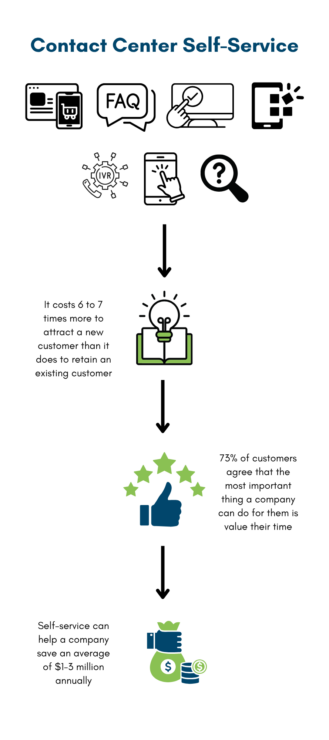Self-service for contact centers refers to the systems that enable customers to resolve their own issues without the assistance of a human agent. Self-service options include IVR, text assistance, chat assistance, web portals, knowledge bases, FAQs, and bots.
Read Time: 18 minutes
Table of Contents
Introduction
In today’s fast-paced digital landscape, contact center self-service options have emerged as essential tools for enhancing customer support and operational efficiency. These technologies empower customers to resolve issues independently, reducing wait times and freeing agents to focus on complex requests. This guide explores the various self-service methods available, from chatbots to knowledge bases, and how businesses can implement them successfully to improve satisfaction, scalability, and productivity.
Key takeaways
- Self-service improves efficiency and customer satisfaction. By enabling customers to resolve routine issues on their own, businesses can reduce wait times, cut operational costs, and deliver faster support.
- Companies should tailor multiple self-service options to their customer care. Virtual assistants, mobile apps, FAQs, and web portals serve different functions and should be carefully selected and integrated based on customer needs and preferences.
- Successful implementation requires strategy and maintenance. To maximize the impact of self-service, businesses must understand their customers’ pain points, choose compatible technologies, regularly update content, and train staff to support the system.
- Self-service enhances scalability and agent productivity. Automating simple requests allows contact centers to handle higher volumes efficiently, empowers agents to focus on complex tasks, and supports business growth without proportional increases in staffing.

What are contact center self-service options?
Self-service is a powerful tool in streamlining customer support and improving the customer experience.
Just like it sounds, self-service empowers customers to help themselves by offering or guiding them to the answers they seek without accessing a human customer support agent.
A mutually beneficial tool for customers and contact centers, self-service reduces queues, providing customers with the instant support they seek while ensuring agents are appropriately optimizing their time and efforts.
This pushes your company forward as a business that smartly uses technology to put your customers first.
There are many ways to implement self-service in your support strategy.
Help customers resolve issues independently by incorporating these self-service contact center tools into your website and communication channels:

IVR

Web portals

Text assistance

Knowledge bases

Chatbots

FAQs
Each of these methods has its own purpose and function, answering customer inquiries at varying levels of success.
Continue reading our guide to learn what are the contact center self-service options that will most effectively aid your audience and enhance their engagement with your company.
How do contact center self-service options work?

Contact center self-service options use various technologies to access your knowledge base, pull information relevant to the query, and communicate the answer to a customer.
As artificial intelligence takes the customer care industry by storm, understanding the role of AI in your technologies will help you tailor your solutions to leverage the most powerful tools for peak operational efficiency.
So how does self-service work?
The process depends on the method, but in general, you handle what information is available to customers by first building out the infrastructure for the type of self-service option you’re using.
For some methods, this is straightforward enough.
Customers interact freely with an IVR menu or communications on your website.
But with certain technologies, such as chatbots or text assistance, these programs do a bit more to simulate human conversation through programming, Natural Language Processing (NLP), and artificial intelligence.
Types of self-service options
Which self-service options you choose to implement determines the customer experience, so carefully selecting the options that will reach your audience and effectively answer their questions is key.
Enhance your contact center self-service by learning about and implementing these self-service options in your strategy.
Interactive Voice Response (IVR)
When customers call a customer support number for a business, they often encounter a menu prompting them to select a number to reach a particular office, agent, or voicemail machine.
These Interactive Voice Response menus can be customized by you and your contact center BPO, if you’re outsourcing customer care, to organize queues and direct customers to the most relevant assistance from the start.
IVRs automate call routing and query resolution with menu-based or AI-driven systems.
This streamlined support reduces wait time and response time, significantly improving customer satisfaction and streamlining your team’s operations.
Access customizable contact center telephony to set up your IVR menu today.

Chatbots and virtual assistants
A chatbot is a computer program that simulates human conversation with a user.
Not all chatbots use artificial intelligence, but contact center technologies use more conversational AI techniques such as NLP to understand user questions and automate responses.
Modern chatbots also use generative AI to better understand complex queries, enhancing their ability to adapt to various styles of conversation, especially with empathy.
This boosts a company’s ability to reach their audience with efficiency, speed, and high-quality engagement, increasing customer satisfaction and retention.
Virtual assistants can also help customers via text messaging or other web chat functionalities, including social media.
Automations scan queries for keywords and provide relevant answers to the customer for instant support.
These AI-powered tools provide instant automated responses on multiple platforms, expanding your reach.
Knowledge bases and FAQs
A knowledge base is a human- and machine-readable database that stores and shares data internally to employees or externally to customers. In self-service, public information is accessible on websites in the forms of guides, tips, FAQs, videos, company information, and troubleshooting guides.
Whatever the method or type of information, the key is that customers easily find answers to their questions through a searchable online library.
Empowering customers to resolve queries without human assistance ensures your employees spend their time on interactions requiring their attention.
To create a customer-facing knowledge base for self-service, develop a strategy based around the goals and purposes of your knowledge base, both from your perspective as the company and the customer’s perspective as the user.
Here are important factors to consider:
Topics or categories to cover
Visuals and multimedia to include
Publishing schedule to follow
How to format the problem and a step-by-step solution
Software to use in content creation and implementation
Phases or steps in the customer journey
Self-service portals and mobile apps
Web or app-based platforms enable customers to directly manage accounts and transactions, reducing the amount of assistance they require from your staff.
These customer portals are private entry points requiring a login for access to exclusive resources.
Apps and software help customers manage their requests at their convenience, delivering on-the-go self-service for maximum convenience.
Examples of contact center self-service options in action
Self-service can sound too good to be true, but is it really?
See how helping customers resolve their own issues drastically enhances the customer experience and yields substantial business results.
These real-world scenarios showcase the successful implementation of self-service tools across industries.
CX Case Study #1
Setting the Standard for Luxury eCommerce
Worldwide luxury sports fashion brand LACOSTE struggled to deliver the high-quality, high-touch service to online customers that their stores were known for, risking the brand’s reputation and customer retention.
LACOSTE partnered with Global Response, who revolutionized their support strategy with dedicated brand specialists and state-of-the-art technology. The new click-to-chat feature utilized live voice, chat, and email response services for real-time personalized assistance.
As a result, the brand saw increased online sales as the personalized buying experience engaged customers better, leading to higher customer satisfaction and retention rates. Global Response provided daily reports on key metrics and customized analytics for further customer and product insights for a lasting impact on the business.
CX Case Study #2
How ASICS boosted performance over 130%
During the COVID-19 pandemic, ASICS required assistance transforming their eCommerce and direct-customer sales via omnichannel support. Global Response stepped in, answering 25,000 backlogged email inquiries and dramatically increasing ASIC’s capacity to interact with their audience.
Global Response used a scalable team cross-trained in omnichannel support, engaging with customers via email, phone, chat, and web portals. The team improved the average speed of answer by more than 40% with a comprehensive and proactive approach to customer care.
Want to scale your business?
Global Response has a long track record of success in outsourcing customer service and call center operations. See what our team can do for you!
Benefits of self-service options for businesses
Self-service is a game-changer not only for the satisfaction of your customers, but also for the health of your business.
Capture all the benefits of enhanced customer self-service in your company by first discovering what they are to ensure you’re making the most of self-service.
Target and achieve your goals by crafting your strategy with these benefits in mind.
Reduced operational costs
Like many initiatives born of operational efficiency, self-service significantly reduces costs of running and maintaining certain business and customer support operations.
More empowered customers means fewer inquiries, at least about simple or routine tasks, which ensures you have the most accurate workforce management strategies for a streamlined but effective team.
Automate repetitive tasks to eliminate the time, effort, and resources internal staff spend on certain requests.
Effectively cut costs in these common requests through effective customer self-service:
- Automate password resets, order tracking, and billing inquiries
- Answer routine questions online or in IVR menus
- Provide troubleshooting assistance in accessible online guides
- Reduce costs of operating a full contact center by focusing on self-service
- Reduce the resources needed to handle certain inquiries
- More efficiently allocate resources to your staff
Improved customer satisfaction
It’s no surprise that faster resolutions lead to happier customers. Dropped calls, long wait times, and holds put customers on edge, enhancing the urgency of their request, even for the more simple queries.
The solution?
Meeting them where they’re at.
Offering the responsive care they expect through around-the-clock assistance. While that may sound like more staff and longer hours, you are unlimited by these options with customer self-service.
Provide comprehensive support to your audience by giving them the tools they need to improve their own experience without burdening them with the work. Implement these best practices to improve your customers’ satisfaction with self-service efforts:
- Make self-service convenient. Let customers take care of their issues on their own time via apps, online guides, and chatbots. Choose a reliable hosting provider to minimize down time and technical issues.
- Make relevant content easy to find. Consider putting guides, references, tips, FAQs, and video assistance in navigational menus, or place links in well-organized social media feeds for users seeking answers there.
- Prioritize a user-friendly interface. Put in the work to research and design an intuitive and smooth self-service experience. Customize your knowledge base, provide a table of contents, or make your website searchable for ease of use.
- Implement case or ticket deflection strategies. Utilize advanced technologies to proactively anticipate concerns and suggest solutions before the customer needs to contact your representatives.
- Analyze feedback. Performance metrics and results not only demonstrate the skill and efficiency of your agents; they can also inform your solutions and how effectively they answer the most common and urgent requests.
24/7 availability
Contact center self-service provides support anytime, even outside business hours.
Grow your reach without necessarily expanding your team by leveraging the power of constantly accessible online assistance. This is also vital for global enterprises whose operating hours vary from their audiences’.
An efficient self-service contact center ensures customers of every region receive the same level of care as walk-in customers.
Pro tip: As you outsource your contact center self-service, select a partner who can implement multilingual self-service options to effectively empower your customers to resolve their requests.
Scalability
Increase the amount of requests your company can handle by building self-service into your operations.
When contact center self-service is an essential part of your operations, the rest of your team can thrive by focusing their time on their specialties.
Enhance your support team’s scalability by automating simple requests and efficiently routing others to the appropriate office or team member.
Empower your team to seamlessly handle high demand during peak times by leveraging the appropriate infrastructure to keep things running smoothly, no matter the volume.
Enhanced agent productivity
One of the biggest roadblocks to employee, customer, and business success is simply overwhelm.
If you value customer service, your agents need to spend a reasonable amount of time answering requests, establishing rapport, and providing high-quality service.
When the call volume stacks up, agents under pressure are rushed to resolve calls more quickly than is ideal, running the risk of harming customer satisfaction.
And still, queues are long, frustrating employees and customers alike.
Outsourced customer care streamlines operations and enhances productivity.
Outsourced contact centers equip your company not only with dedicated agents but also with simple yet powerful self-service technology and strategies, freeing up the agents and your internal team to handle complex queries.
When unburdened by routine tasks and answering the same questions over and over again, employees experience higher satisfaction, lowered burnout, and more time to focus on issues that require human attention.
You can rest easy knowing your team is putting their efforts toward high-pressure issues, demonstrating your team’s competency in handling a variety of issues, even among high stakes.

Key features of effective self-service solutions
Not all self-service is created equally.
As you search for a contact center partner for self-service, look for these vital features of the options to ensure they operate as needed and provide the assistance your audiences expect.
Personalization
Audiences can only find the answers they seek if their solutions are customizable to them.
While published content remains static on your site, fully developed content should still anticipate a variety of problems and provide a host of solutions.
High-quality, comprehensive material ensures a customizable user experience.
Your chatbots and automated technology can also provide this flexible, customizable assistance in real time.
Chatbots and IVR menus should be able to understand human inputs and use AI to tailor solutions to individual needs.
How does personalized self-service look in practice?
We have a couple ideas:
- Personalized web portals and customizable customer dashboards in apps
- Troubleshooting help broken into categories with detailed questions and solutions
- Easy to understand interactive content
- Readily available links or phone numbers for additional support
- Functional personal assistants that smoothly escalate complex issues
- Customized suggestions based on past history or recent purchases
- A centralized database with access to multiple tools in one place
Multi-channel integration
Customers come to your business from a variety of origins, both virtual and physical. Ensure a unified customer experience across platforms by implementing seamless omnichannel support.
Integrating your solutions in web, phone, chat, text, video, and social media platforms ensures you never drop communication with customers and you handle conversations with transparency and consistency.
Teams at Global Response analyze data from each touchpoint of the customer journey, personalizing service and facilitating smooth integrations with your technology.
This ensures a secure handling of customer information, streamlining operations through multiple channels.
Intuitive user interfaces
Without a user-friendly look and an intuitive feel across your website, customers won’t stick around long enough to find the answers they seek.
Usability and readability are vital to ensuring customers will actually complete the clicks necessary to navigate to your self-service options.
The key? Simplicity.
Simplifying access to resources reduces the room for error and bridges gaps in understanding across users of all demographics.
Prioritize the user experience in the design of your tools to encourage customers to continue looking to your business as a reliable resource and trustworthy solution.
Security and privacy
Contact center self-service allows customers to do more without relying on your internal resources, but it doesn’t mean sacrificing their own information and data security.
In fact, self-service can reduce errors by protecting customer data with robust safeguards.
Secure apps safely handle information behind password-protected logins.
This also securely handles your own company information and exclusive resources. Streamline processes to facilitate smooth experiences across a variety of requests and channels.
Your AI technologies enhance compliance in all interactions, flagging potential issues for correction before they escalate.
Chatbots provide secure responses, and you can rest easy knowing your constantly updated knowledge base provides accurate answers to all requests.
How to implement self-service options successfully
Creating these self-service options should be intentional from the start of the process to the implementation of each solution. Ensure powerful self-service by following these steps and tips for successfully implementing a host of self-service options into your customer care operations.
1. Understand your customers’ needs
Solutions are only as good as the questions they answer—and if you’re not asking the right questions, your customers leave frustrated.
To prevent this, conduct careful research before you even start thinking about self-service methods. This begins with identifying key pain points and all required or possible solutions.
This is a prime time to take a walk throughout the customer journey, as if you were a customer.
Try these ideas to get a clear picture of possible pain points and any urgent issues:
- Replicate common tasks
- Submit a support ticket
- Anticipate and act out what you would do in the face of a variety of product or service problems
Once you’ve walked through various processes, you can put on your problem-solving hat.
Create a map of the problems and solutions, scoring each idea in order of effectiveness and including special tips, troubleshooting ideas, and decision trees for various scenarios.
2. Choose the right technology
The contact center landscape is teeming with technology options for each process and aspect of customer care. Try a variety of demos and meet with a host of possible contact center BPO partners to ensure you select a strategy that aligns with your business needs and goals.
Invest in scalable tools that will empower you to scale operations drastically, as your business experiences expected seasonal demand surges or unexpected growth.
You don’t want to be limited by your tools—they should support and power exponential growth!
Contact center technologies should also be compatible with your existing CRM for a smooth takeover of operations unless you’re prepared to switch gears and implement a new system.
Many easily integrate with websites and platforms, but double check to ensure compatibility.
Test them for usability as agents and managers to anticipate the usage of these tools in your future operations.
3. Provide continuous updates
Software updates should be implemented regularly to minimize bugs and errors.
Craft and implement a plan for updating your knowledge base to ensure customers access accurate answers, every time.
Regularly refresh your resources to stay relevant and increase your credibility with your audience.
4. Train your team
Implementing new technology can introduce learning curves to your team, threatening efficiency and employee confidence and proficiency.
Combat this with regular agent training.
Educate staff to support self-service adoption.
Remind them that these options support them, reducing their workloads and enabling them to focus on unique or complex issues.
Don’t overlook the importance of individual and team trainings.
Continuous agent training:
Make constant improvement a staple of your operations by using contact center technologies that score interactions and provide instant insight into performance with automated summaries, notes, and suggestions. Capture potential problem areas early to proactively reduce errors and build your agents’ skills. As you do, they really will be able to tackle the most complex issues while the automations handle simple ones.
Regular team training:
Engage your team in the development of these self-service options to get each agent on the same page as to how to handle complex requests, how to route simple ones that make their way to their queues, and how to access knowledge bases for streamlined support. Gathering as a team will also boost morale and share knowledge and insights into valuable customer and agent behaviors.
Industries leveraging contact center self-service options
Self-service is taking customer support by storm.
A host of industries are implementing all of the above self-service methods in their operations, powering teams to handle more requests in less time than ever before.
Not sure if self-service is right for your industry?
We have insights about the impact of self-service on the functionality and growth of the following industries:
Online shopping provides a wealth of opportunities for customers to contact your business for assistance.
Unlimited by access to brick-and-mortar stores, business hours, and even sometimes shipping location, customers can engage with your business and offer their opinions with more insight and detail than you might have ever anticipated.
Self-service can greatly reduce overwhelm, specifically for these issues:
- Product issues and returns
- Billing and shipping information
- Order history inquiries
- Order tracking
- Order cancellations
- Subscription payment updates and pauses
- End-to-end shopping experience
- Product information and usage education
- And many more!
With customer self-service handling these issues, your team can focus on generating revenue for the business by developing relationships with customers and offering natural and relevant product upselling or cross-selling opportunities.
No matter the service, healthcare companies of all types can reach more patients, set appointments, and handle complicated requests when self-service handles the routine. Implement these necessary healthcare self-service options in your operations to power capable, compassionate care.
- Patient intake – to improve access to Electronic Medical Records
- Check-in kiosks – to reduce wait times
- Online payment portals – to update insurance and other payment information
- Patient-provider communications – to enrich education and communicate urgent notices
- Online surveys – to collect feedback about care
As patients can more seamlessly interact with your healthcare solutions via self-service, they can focus on receiving—and your internal staff can offer—necessary care, enhancing the productivity and financial health of your organization.
Customers come to your financial institution with a variety of purposes, emotions, histories, and requests, and self-service can manage those efficiently for the betterment of your customers and your expert team, improving relationships between your clients and boosting the success of your company.
Here are some ways self-service tools can streamline your financial operations and improve the customer experience:
- Online banking services
- Tax preparation software
- Employee payroll
- Interactive kiosks and ATMs
- Budget creation and monitoring
- Goal tracking
- Invoicing and billing
- Issue reporting
- Portfolio management
- Risk assessment
Financial self-service offers dynamic interactions with all types of accounts.
Empower customers to receive real-time updates and critical information through secure apps and self-service solutions.
Challenges and considerations for contact center self-service options
As with anything, self-service comes with its own obstacles—and, thankfully, solutions. Implementing chatbots and developing a comprehensive knowledge base can kick off without a hitch, but technical complexity can bug up even these options, causing you more pain in the long run.
Our tip?
Select industry-leading cutting-edge software known for their security and high-quality functionality.
Need help selecting the best tech for your company?
Partner with Global Response to access advanced technical support and reliable self-service solutions.
Another possible roadblock to successful contact center self-service is maintaining customer satisfaction.
As automations dominate support operations, customers want, need, and seek more human support than ever. Sometimes customers prefer speaking to a live agent to skip the bots and receive the empathy they expect.
At Global Response, we prioritize combining the best of artificial intelligence with human intelligence.
We utilize automations for streamlined support and optimal coverage and we train agents to offer high-quality compassionate assistance in all interactions.
We use data to inform our decisions and anticipate customer issues, cultivating customer loyalty one positive experience at a time.
Why self-service is the future of contact centers
Self-service is a powerful tool in driving customer satisfaction.
As AI-driven tools are constantly improving, learning to understand human behavior with more sophistication and nuance than ever, they are reshaping the support industry.
Self-service teaches companies the importance of understanding fluctuating customer demands and respectfully tending to simple, routine ones.
By cultivating a comprehensive customer journey informed by strategies that streamline support, companies boost efficiency and customer satisfaction, cultivating relationships with professionalism, convenience, and care.







